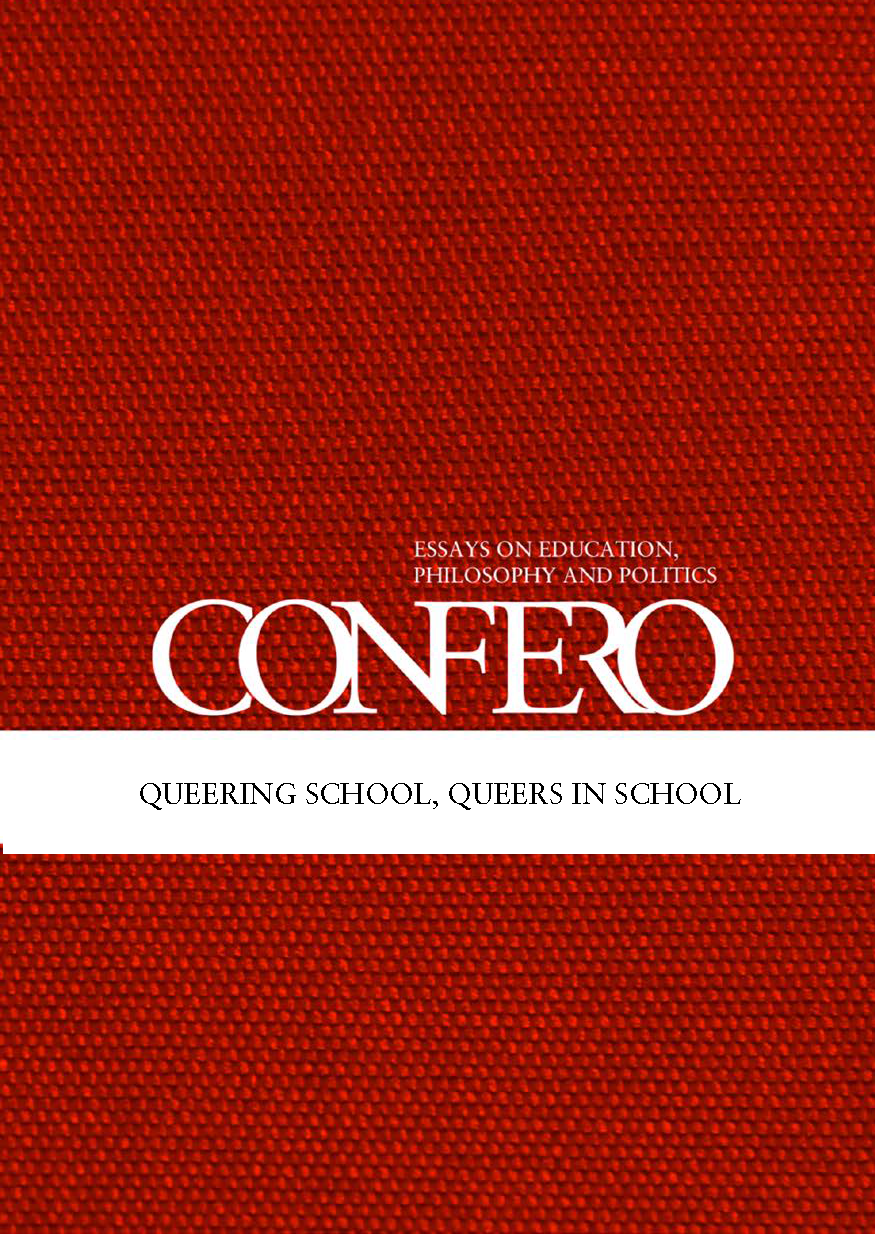Queering School, queers in school
An introduction
DOI:
https://doi.org/10.3384/confero.2001-4562.13v1i21gAbstract
Queer studies of education have become a growing field with a range of theoretical and political positions and methodological approaches. Moreover, research with lesbian, gay, bisexual, transgender and queer (LGBTQ) kids is tightly connected to anti-homophobia, anti-transphobia and norm-critical activism. One of the key contentions within this field is what researchers and activists mean by “queer” in the context of education: is it a focus on queer/ed subjectivities? Is it about using queer theories to critique forms and norms of education in a given sociopolitical context? Who is queer/ed in schools? Is the language of homophobia and transphobia the best or even correct way to describe and analyse normative educational settings and frameworks?
References
Birkett, Michelle, Dorothy Espelage, and Brian Koeing. “LGB and questioning students in school: the moderating effects of homophobic bullying and school climate on negative outcomes.” Journal of Youth Adolecence 38 (2009): 989-1000.
Black, Whitney, Alicia Fedewa and Kirsten Gonzalez. “Effects of ‘safe school’ programs and policies on the social climate for sexual-minorty youth: A review of literature.” Journal of LGBT Youth 9 (2012): 321-339.
Blackburn, Mollie, and Lance McCready. ”Voices of queer youth in urban schools: Possibilities and limitations.” Theory into practice 48 (2009): 222-230.
Bromseth, Janne, and Frida Darj (eds.). Normkritisk pedagogik. Makt, lärande och strategier för förändring. Uppsala: Uppsala University, 2010.
Connell, Chatriene, and Sinikka Elliott. “Beyond the birds and the bees: Learning inequality through sexuality education.” Amercian Journal of Sexuality Education 4 (2009): 83-102.
Elia, John, and Mickey Eliason. “Dangerous omissions: Abstinence-only-until-marriage school-based sexuality education and the betrayal of LGBTQ youth.” American Journal of Sexuality Education 5 (2010): 17-35.
Fetner, Tina, Athena Elafros, Sandra Bortolin, and Coralee Drechsler. “Safe spaces: Gay-straight alliances in high schools”. Canadian Review of Sociology (2012): 188-207.
Formby, Eleanor. “Sex and relationships education, sexual health, and lesbian, gay and bisexual sexual cultures: Views from young people”. Sex Education 11.3 (2011): 255-266.
Goodrich, Kristopher, and Melissa Luke. “LGBTQ Responsive School Counseling.” Journal of LGBT Issues in Counseling 3 (2009): 113-127.
Greytak, Emily, Joseph Kosciw, and Madelyn Boesen. “Educating the educator: Creating supportive school personnel through professional development.” Journal of School Violence 12 (2013): 80-97.
Grossman, Arnold, Adam Haney, Perry Edwards, Edward Alessi, Maya Ardon, and Tamika Jarrett Howell. “Lesbian, gay, bisexual and transgender youth talk about experieces and coping with school violence: A qualitative study.” Journal of LGBT Youth 6 (2009): 24-46.
Gustavson, Malena, and Irina Schmitt. “Culturally queer, silenced in school? Children with LGBTQ parents, and the everyday politics of/in community and school.” Lambda Nordica. Tidskrift för homo/lesbisk/bi/transforskning vol. 16.2-3 (2011): 159-187.
Haskell, Rebecca, and Brian Burtch. Get that freak. Homophobia and transphobia in High Schools. Black Point: Fernwood, 2010.
Heck, Nicholas, Lauri Lindquist, Brandon Stewart, Christoffer Brennan, and Bryan Cochran. “To join or not to join: Gay-straight student alliances and the high school experiences of lesbian, gay, bisexual and transgender youths.” Journal of Gay and Lesbian Social Services 25 (2013): 77-101.
Kitchen, Julian, and Christine Bellini. “Making it better for lesbian, gay, bisexaul and transgender students through teacher education: A collaborative self-study.” Studying Teacher Education 8.3 (2012): 209-225.
Kumashiro, Kevin K. Troubling intersections of race and sexuality : queer students of color and anti-oppressive education. Lanham: Rowman & Littlefield, 2010.
MacIntosh, Lori. “Does Anyone Have a Band-Aid? Anti-Homophobia Discourses and Pedagogical Impossibilities.” Educational Studies 41.1 (2007): 33-43.
Meiners, Erica R., and Therese Quinn (eds.). Sexualities in Education: A Reader. New York: Peter Lang, 2012.
Puar, Jasbir. Terrorist assemblages: Homonationalism in queer times. Durham: Duke University Press, 2007.
Rasmussen, Mary Louise. Becoming subjects. Sexualities and secondary schooling, New York/London: Routledge, 2006.
Røthing, Åse, and Stine Helena Bang Svendsen. Seksualitet i skolen. Perspektiver på undervisning. Oslo: Cappelen akademisk, 2009.
Schmitt, Irina. Sexuality, secularism and the nation - reading Swedish school policies. In Meiners, Erica R. & Therese Quinn (eds.), Sexualities in Education: A Reader. New York: Peter Lang, 2012.
Talburt, Susan, and Mary Lou Rasmussen “'After-queer' tendencies in queer research.” International Journal of Qualitative Studies in Education 23.1 (2010): 1-14.
Downloads
Published
Issue
Section
License
Copyright (c) 2013 Anna Malmquist, Malena Gustavson, Irina Schmitt

This work is licensed under a Creative Commons Attribution 4.0 International License.
As Confero is an open access journal, this means that anyone who can access the Internet can freely download and read the journal. There are no commercial interests for Linköping University Electronic Press or Confero in publishing the journal.
The core idea of open access is that copyright remains with the author(s). However, we publish with the agreement of the author that if she or he decides later to publish the article elsewhere, that the publisher will be notified, prior to any acceptance, that the article has already been published by Confero.
When publishing with Confero, it is with the agreement of the author that if they make their article available elsewhere on the internet (for example, on their own website or an institutional website), that they will do so by making a link to the article as published in Confero using the Digital Object Identifier (DOI) number of the article and acknowledge in the text of the site that the article has been previously published in Confero.
As evident by the markers on our homepage, Confero falls under the Creative Commons licence abbreviated BY. This means that we allow others to use, spread and elaborate on the published articles, as long as they acknowledge who published it and where it was originally published.



